|
|
|
Sort Order |
|
|
|
Items / Page
|
|
|
|
|
|
|
| Srl | Item |
| 1 |
ID:
130331


|
|
|
|
|
| Publication |
2014.
|
| Summary/Abstract |
Thomas Countryman took office as assistant secretary of state for international security and nonproliferation on September 27, 2011. He joined the U.S. Foreign Service in 1982. He was lead negotiator for the United States in the talks that produced the Arms Trade Treaty (ATT) last year. Arms Control Today spoke with Countryman in his office on March 12. Countryman was joined by William Malzahn, senior coordinator in the Office of Conventional Arms Threat Reduction. In the interview, Countryman explained the reasons that the United States signed the ATT, addressed domestic criticism of the pact, and looked ahead to the challenges that the treaty faces.
|
|
|
|
|
|
|
|
|
|
|
|
|
|
|
|
| 2 |
ID:
130322
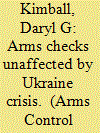

|
|
|
|
|
| Publication |
2014.
|
| Summary/Abstract |
Although the widening confrontation over the political future of the Crimean peninsula and other parts of the former Soviet Union has ruptured already-strained relations between Moscow and the West and put at risk the implementation of some nuclear risk-reduction initiatives and agreements, Russia is not planning to stop allowing the on-site inspections required under the 2010 New Strategic Arms Reduction Treaty (New START), Russian officials said last month. To protest Russia's actions to take control of Crimea, the seven non-Russian members of the Group of Eight (G-8) industrialized countries have suspended Russia's membership in the group. As part of that decision, the seven countries-Canada, Italy, France, Germany, Japan, the United Kingdom, and the United States-changed the location of their planned June summit from Sochi to Brussels. The Russian actions in Crimea have disrupted planning for the activities of the Global Partnership against the Spread of Weapons and Materials of Mass Destruction, which the G-8 launched in 2002.
|
|
|
|
|
|
|
|
|
|
|
|
|
|
|
|
| 3 |
ID:
130356
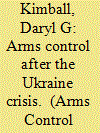

|
|
|
|
|
| Publication |
2014.
|
| Summary/Abstract |
The Global Nuclear Disarmament and risk reduction enterprise is at a crossroads as U.S.-Russian relations have reached perhaps their lowest point in more than a quarter century. Nevertheless, it remains in U.S. and Russian interests to implement existing nuclear risk reduction agreements and pursue practical, low-risk steps to lower tensions. Present circumstances demand new approaches to resolve stubborn challenges to deeper nuclear cuts and the establishment of a new framework to address Euro-Atlantic security issues.
Even before the recent political turmoil in Ukraine and Russian President Vladimir Putin's extralegal occupation and annexation of Crimea, relations between Moscow and Washington were chilly. Despite U.S. adjustments to its missile defense plans in Europe that eliminate any threat to Russian strategic missiles, Putin rebuffed U.S. President Barack Obama's proposal last June to reduce U.S. and Russian strategic stockpiles by one-third below the ceilings set by the New Strategic Arms Reduction Treaty (New START).
Moving forward will be difficult, but doing nothing is not an option. Through earlier crises during and after the Cold War, U.S. and Russian leaders pursued effective arms control and disarmament initiatives that increased mutual security and significantly reduced the nuclear danger. Much has been achieved, albeit too slowly, but there is far more to be done.
As the world's non-nuclear-weapon states persuasively argue, U.S. and Russian stockpiles still far exceed any plausible deterrence requirements, and the use of just a few nuclear weapons by any country would have catastrophic global consequences. As the 2015 Nuclear Nonproliferation Treaty (NPT) Review Conference approaches, pressure to accelerate action on disarmament will only grow.
For now, neither Russia nor the United States wants to scrap the existing arms control regime, including New START and the Intermediate-Range Nuclear Forces (INF) Treaty, which provide greater predictability and stability in an otherwise strained bilateral relationship. A return to a period of unconstrained strategic nuclear competition would not only deepen the distrust and increase dangers for both sides, but also would undermine the NPT. Scrapping the existing nuclear risk reduction measures would do nothing to protect Ukraine from further Russian aggression or reassure nervous NATO allies.
Unfortunately, the profound tensions over Ukraine delay the possibility of any formal, bilateral talks on nuclear arms reductions and missile defense. In light of these realities, Obama and other key leaders must explore alternative options to reduce global nuclear dangers and defuse U.S.-Russian strategic tensions.
|
|
|
|
|
|
|
|
|
|
|
|
|
|
|
|
| 4 |
ID:
130342


|
|
|
|
|
| Publication |
2014.
|
| Summary/Abstract |
As the U.S. government winds up an interagency review of rules governing the export of large drones, the conflicting goals of nonproliferation and commerce are creating a new test of the 27-year-old Missile Technology Control Regime (MTCR). Observers do not expect big changes to the MTCR, which seeks to prevent the proliferation of unmanned systems capable of delivering weapons of mass destruction. The MTCR, a voluntary arrangement that now includes 34 countries, originally was intended to curb the spread of ballistic missiles and unmanned vehicles capable of carrying nuclear weapons. In 1993 it was amended to control systems carrying any weapons of mass destruction. It has become Washington's chief tool for controlling the spread of armed drones. "It's quite unlikely that we will see any radical change in the MTCR," Eric McClafferty, an attorney at Kelley Drye and Warren, a law firm in Washington that represents UAV manufacturers, said in a March 19 interview. "That said, there's a lot of pressure on the U.S. government to liberalize controls to make sure the U.S. doesn't get left behind in this market." The conflict has played out in a series of closed-door meetings over the last two months among the State, Defense, and Commerce departments as officials seek to update U.S. policy toward the burgeoning UAV market. Industry representatives have made their views known via technical committees that advise policymakers in these departments. "It's a pretty contentious fight" between the State Department's Bureau of International Security and Nonproliferation and the Pentagon's Defense Technology Security Administration, said Micah Zenko, a fellow at the Council on Foreign Relations, in a March 17 interview. The State Department says that "if you pull at the thread of MTCR, you will weaken the nonproliferation regime as a whole. The other side says the international market is going to supply these UAVs anyway," Zenko said. The heart of the issue is what kind of UAVs U.S. manufacturers can sell overseas. The MTCR imposes a "presumption of denial" for the export of so-called Category 1 UAV's, which are drones that can travel more than 300 kilometers with a payload of more than 500 kilograms. Drones that do not have those capabilities are classified as Category 2 UAVs and are not subject to such restrictive criteria. Two drones currently classified as Category 1-the Reaper, formerly known as the Predator, and the Global Hawk-have played a central role in U.S. aerial attacks on suspected Islamic militants in Pakistan, Somalia, and Yemen. Washington has approved the sale of an armed drone to only one country, the United Kingdom, although unarmed versions of these drones have been sold to Italy and South Korea.
The stakes of the MTCR review process are large politically and economically, observers say.
|
|
|
|
|
|
|
|
|
|
|
|
|
|
|
|
| 5 |
ID:
130351
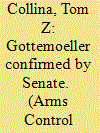

|
|
|
|
|
| Publication |
2014.
|
| Summary/Abstract |
In the face of accusations that the administration had withheld information from Congress on possible Russian Violations of an arms treaty, the Senate on March 6 voted to confirm President Barack Obama's choice to be his top arms control official. Rose Gottemoeller, first nominated in September 2012 to replace Ellen Tauscher as undersecretary of state for arms control and international security, had been serving as acting undersecretary and as assistant secretary for arms control, verification, and compliance. She was the main U.S. negotiator of the New Strategic Arms Reduction Treaty (New START), which the Senate approved in December 2010. The Senate approved Gottemoeller's nomination by a nearly party-line vote, 58-42, with the support of 50 Democrats, six Republicans, and two independents. Three Democrats and 39 Republicans were opposed. The Republicans voting for Gottemoeller were Lamar Alexander (Tenn.), Susan Collins (Maine), Bob Corker (Tenn.), Jeff Flake (Ariz.), Johnny Isakson (Ga.), and Lisa Murkowski (Alaska). The Democrats opposing her were Heidi Heitkamp (N.D.), Jon Tester (Mont.), and John Walsh (Mont.). After being approved twice by the Senate Foreign Relations Committee, once last October and again in February, Gottemoeller's nomination was held up by Sen. Marco Rubio (R-Fla.) and others over concerns that the administration had dragged its feet in informing them about Russia's possible violation of the 1987 Intermediate-Range Nuclear Forces (INF) Treaty. (See ACT, March 2014.) In a Feb. 28 statement, Rubio and Sens. John Cornyn (R-Texas) and James Risch (R-Idaho) accused Gottemoeller of "failing to quickly pursue evidence of Russia's [non]compliance with multiple arms control agreements and her delay in making the Senate aware of these violations." The three senators also said they were "frustrated" that the administration did not make a written commitment that "any future U.S. nuclear reductions would be carried out only through a treaty subject to the advice and consent of the Senate" and not by unilateral or other means that did not involve a treaty, such as reciprocal reductions carried out by the United States and Russia in 1991. At Gottemoeller's confirmation hearing Sept. 26, Rubio pressed her on the issue of unilateral cuts. Gottemoeller replied that the administration had already begun to pursue an arms control treaty with Russia, a process she described as "a difficult slog." She said that "unilateral reductions are not on the table," but did not rule them out in the future. (See ACT, November 2013.)
|
|
|
|
|
|
|
|
|
|
|
|
|
|
|
|
| 6 |
ID:
130360
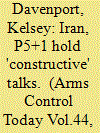

|
|
|
|
|
| Publication |
2014.
|
| Summary/Abstract |
Iran and six world powers held "constructive and useful" talks on a comprehensive deal on Iran's nuclear program, according to a March 19 joint statement released by the parties. A main topic of the talks between Iran and the six-country group, known as the P5+1 (China, France, Germany, Russia, the United Kingdom, and the United States), was Iran's uranium-enrichment program. The March 17-19 talks in Vienna were the second set of meetings between Iran and the P5+1 on a comprehensive deal on Iran's nuclear program after the parties reached an interim agreement in November. Implementation of the initial actions began Jan. 20 and is to last six months. If an agreement is not reached, the interim deal can be extended by mutual consent of the two sides. U.S. officials have said they hope to reach a final deal within the first six months. Iran maintains that its nuclear program is for peaceful purposes, but some countries are concerned that Iran could use its nuclear capabilities to develop nuclear weapons.
|
|
|
|
|
|
|
|
|
|
|
|
|
|
|
|
| 7 |
ID:
130347


|
|
|
|
|
| Publication |
2014.
|
| Summary/Abstract |
The recently unveiled budget for the Defense Department's Missile Defense Agency (MDA) focuses on restoring confidence in the Ground-Based Midcourse Defense (GMD) system while keeping other aspects of the Obama administration's ballistic missile defense plans moving forward. The administration's missile defense budget request for fiscal year 2015 came in at $8.5 billion, including $7.5 billion for the MDA, representing a stable funding level compared to previous years despite cuts in other parts of the defense budget. Congress appropriated $7.6 billion for the MDA for fiscal year 2014.
In the March 4 press conference announcing the budget, MDA Director Vice Adm. James Syring said that the MDA will invest approximately $100 million to "initiate the redesign" of the Ground-Based Interceptor (GBI) kill vehicle, the part of the interceptor designed to seek out and destroy an incoming missile with a kinetic impact. A separate line item of around $26 million is devoted to "common kill vehicle technology," which will be used to "breed the technologies and improvements" for the GBI kill vehicle and potentially other interceptors such as the Standard Missile-3 (SM-3), Syring said. The GMD system has not had a successful intercept test since 2008, and the two currently deployed versions of the GBI kill vehicle, the CE-I and CE-II, have failed to intercept targets in the three tests since then. Frank Kendall, undersecretary of defense for acquisition, technology, and logistics, said in recent remarks that the GBI system suffered from "bad engineering" due to an accelerated deployment schedule.
|
|
|
|
|
|
|
|
|
|
|
|
|
|
|
|
| 8 |
ID:
130349


|
|
|
|
|
| Publication |
2014.
|
| Summary/Abstract |
The Energy Department announced last month that it has decided to mothball the facility that has been the centerpiece of its effort to get rid of plutonium from the U.S. nuclear weapons program as the department reviews other options for that task. In public comments by department officials and in budget documents for fiscal year 2015, the department said it was putting the facility into "cold standby," meaning that work on the structure will be scaled back to activities such as protecting the facility and its equipment from the elements and keeping the site secure. Those activities would preserve the facility for some potential future use. The facility is under construction by an Energy Department contractor at the department's Savannah River Site in South Carolina. It is designed to turn the plutonium into mixed-oxide (MOX) fuel-so called because it is a mix of plutonium and uranium oxides-for use in nuclear power reactors.
Under an agreement that Russia and the United States signed in 2000, each country is required to dispose of at least 34 metric tons of surplus weapons plutonium. In the United States, that mission is the responsibility of the National Nuclear Security Administration (NNSA), a semiautonomous unit of the Energy Department. The NNSA budget request for fiscal year 2015 would provide $196 million for construction of the MOX fuel fabrication plant and another $25 million for other associated costs, down from $344 million and $40 million appropriated for the current fiscal year. Spending for Fissile Materials Disposition, the section of the NNSA budget that includes those expenditures, would drop from $526 million to $311 million. During a March 4 conference call with reporters, Anne Harrington, NNSA deputy administrator for defense nuclear nonproliferation, said the ongoing analysis of plutonium disposition options had not eliminated the current approach as an option. But keeping that approach would require the facility's total life-cycle costs to decrease considerably, she said. Those costs are now estimated to be about $30 billion, according to the Energy Department.
|
|
|
|
|
|
|
|
|
|
|
|
|
|
|
|
| 9 |
ID:
130333
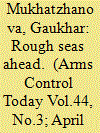

|
|
|
|
|
| Publication |
2014.
|
| Summary/Abstract |
From April 28 to May 9, states-parties to the nuclear Nonproliferation Treaty (NPT) will gather in New York for the third and final meeting of the Preparatory Committee for the 2015 NPT Review Conference.[1] Although it is unlikely that states will try to negotiate substantive recommendations for the review conference, the preparatory meeting is still an opportunity to take stock of developments and assess the condition of the regime as the treaty approaches the 45th anniversary of its entry into force.
More than a year away, the 2015 review conference is promising to be highly contentious, with the Middle East and nuclear disarmament at the center of tensions among the parties and progress on both issues viewed as a test of the treaty's credibility. The rapidly evolving initiative centered on the humanitarian impact of nuclear weapons is reshaping the traditional NPT debate, challenging the incremental approach to disarmament. The events unfolding in Ukraine may yet have a serious impact, reaffirming the belief among some that nuclear weapons or protection of a nuclear alliance are necessary for national security and further diminishing the possibility of any progress on disarmament. On the other hand, the crisis might help re-energize the discourse on the risks of escalation and use of nuclear weapons.
|
|
|
|
|
|
|
|
|
|
|
|
|
|
|
|
| 10 |
ID:
130339
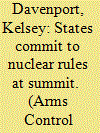

|
|
|
|
|
| Publication |
2014.
|
| Summary/Abstract |
Thirty-five countries last month launched an initiative that they said bolsters their commitment to implementing existing international guidelines on nuclear security, in part by incorporating the "fundamentals" of the voluntary guidelines into binding national rules The initiative was announced at the March 24-25 nuclear security summit in The Hague, the third in the series of biennial meetings. In a March 25 press conference in The Hague announcing the initiative, U.S. Energy Secretary Ernest Moniz said the initiative is the "closest thing we have to international standards for nuclear security.
|
|
|
|
|
|
|
|
|
|
|
|
|
|
|
|
| 11 |
ID:
130372


|
|
|
|
|
| Publication |
2014.
|
| Summary/Abstract |
Syria has picked up the pace in removing its chemical weapons materials for overseas destruction and has sent about half of its stockpile out of the country, according to figures in a March 20 press release from the Organisation for the Prohibition of Chemical Weapons (OPCW). Syria had been under broad international pressure to speed up the effort. By the end of February, it had made four shipments, removing about 5 percent of its so-called Priority 1 chemicals and about 20 percent of the Priority 2 chemicals. Citing those figures, Robert Mikulak, the U.S. ambassador to the OPCW, had accused Syria of "continu[ing] to drag its feet." (See ACT, March 2014.) Under a schedule set last November by the OPCW Executive Council, the Priority 1 materials were supposed to leave the country by Dec. 31. All other materials that are part of the overseas destruction program were to leave by Feb. 5. The rest of the approximately 1,300 metric tons of chemical agents that Syria declared is to be destroyed within the country. The removal dates were set with an eye to a June 30 deadline for destruction of the chemical agents, which was established last September by the Executive Council and the UN Security Council. (See ACT, October 2013.)
|
|
|
|
|
|
|
|
|
|
|
|
|
|
|
|
| 12 |
ID:
130345


|
|
|
|
|
| Publication |
2014.
|
| Summary/Abstract |
Despite pressure to reduce military budgets, the Obama administration is planning to increase spending significantly to modernize nuclear-armed missiles, submarines, and bombers and to maintain nuclear warheads in the decades ahead, according to budget documents released in March Defense Secretary Chuck Hagel testified before the House Armed Services Committee on March 6 that "tough, tough choices are coming" if the Pentagon is forced to make deep spending cuts as required by law. The services are considering cutting 20,000 to 30,000 soldiers and retiring an aircraft carrier, among other money-saving steps.
But the Pentagon is not proposing to scale back its highest-priority nuclear modernization programs. The Pentagon's proposed $496 billion budget for fiscal year 2015, released March 4, would "preserve all three legs of the nuclear triad," Hagel said, and includes hefty down payments for new delivery systems. The nuclear warhead programs, overseen by the National Nuclear Security Administration (NNSA), a semi-autonomous unit of the Energy Department, also would get a budget increase. The administration would pay for these increases in part by cuts to some lower-priority programs.
|
|
|
|
|
|
|
|
|
|
|
|
|
|
|
|
| 13 |
ID:
130373


|
|
|
|
|
| Publication |
2014.
|
| Summary/Abstract |
UN member states should focus on significantly improving implementation of existing sanctions to slow North Korea's prohibited nuclear and ballistic missile programs rather than passing new measures, a March 6 report to the UN Security Council recommended. The report, written by a panel of experts authorized under UN Security Council Resolution 1874 in 2009, found that North Korea has developed "multiple and tiered circumvention techniques" to evade sanctions and continue work on the banned programs but that states have "adequate tools" to prevent Pyongyang's illicit trafficking.
Together, Resolutions 1718, 1874, 2087, and 2094 prohibit arms sales and transfers of nuclear and ballistic missile technology to North Korea, ban the sale of luxury items to Pyongyang, and give states broad authority to inspect North Korean cargo suspected of violating these measures if it passes through their territories. The mandate for the panel of experts includes assessing the effect of the sanctions on North Korea's nuclear and missile programs and providing recommendations for better implementing restrictive measures on Pyongyang. An incident last July involving a North Korean ship carrying Cuban weapons helped inform the panel's recommendations, as it gave them "unrivalled insight" into the ways that Pyongyang circumvents sanctions, the report said. Panama stopped the ship carrying Cuban weapons to North Korea on July 15, charging a violation of UN Security Council sanctions that prohibit transfers of arms to Pyongyang. (See ACT, September 2013.) According to a July 16 statement by the Cuban Foreign Ministry, the "obsolete defensive weaponry," made in the Soviet Union, was being shipped to North Korea for repair. After investigating the ship's cargo, the panel found that the shipment violated UN Security Council resolutions prohibiting the "indirect supply, sale or transfer" of arms to North Korea. Under the resolutions, Pyongyang also is not permitted to provide "technical training, advice, services or assistance" related to the maintenance of weaponry, the panel said. According to the report, the illegal cargo was hidden among bags of sugar and included two MiG aircraft, 15 MiG aircraft engines, components for surface-to air-missiles, ammunition, and "miscellaneous arms-related material."
|
|
|
|
|
|
|
|
|
|
|
|
|
|
|
|
| 14 |
ID:
130326


|
|
|
|
|
| Publication |
2014.
|
| Summary/Abstract |
In November 2013, Iran and the P5+1 group of countries (China, France, Germany, Russia, the United Kingdom, and the United States) agreed on a six-month Joint Plan of Action to enable negotiations on a final settlement to contain the proliferation risks from Iran's nuclear program. This interim agreement freezes Iran's enrichment capacity, thereby preventing a further shortening of the time Iran would require to produce weapons quantities of highly enriched uranium (HEU) if it wished.1 This enrichment capacity has expanded greatly over the years since it first came to international attention in 2002. Iran and the P5+1 also have agreed on the need to constrain Iran's option to produce plutonium for weapons using the reactor that is under construction near the city of Arak and that will be under International Atomic Energy Agency (IAEA) safeguards. Under the Joint Plan of Action, Iran has agreed to freeze the Arak reactor project for six months.2 It also has committed not to separate plutonium from spent nuclear fuel or construct a facility capable of doing so. These are important interim commitments. According to Ali Akbar Salehi, the head of the Atomic Energy Organization of Iran, the Arak reactor is intended for radioisotope production and testing of nuclear fuel and materials. In response to the P5+1 proposal that Iran scrap the Arak reactor project, Salehi stated that "we see no point stopping the work on this reactor." He has acknowledged, however, the international community's concerns about the Arak reactor and offered the possibility of design changes "in order to produce less plutonium in this reactor and in this way allay the worries and mitigate the concerns.
|
|
|
|
|
|
|
|
|
|
|
|
|
|
|
|
|
|
|
|
|